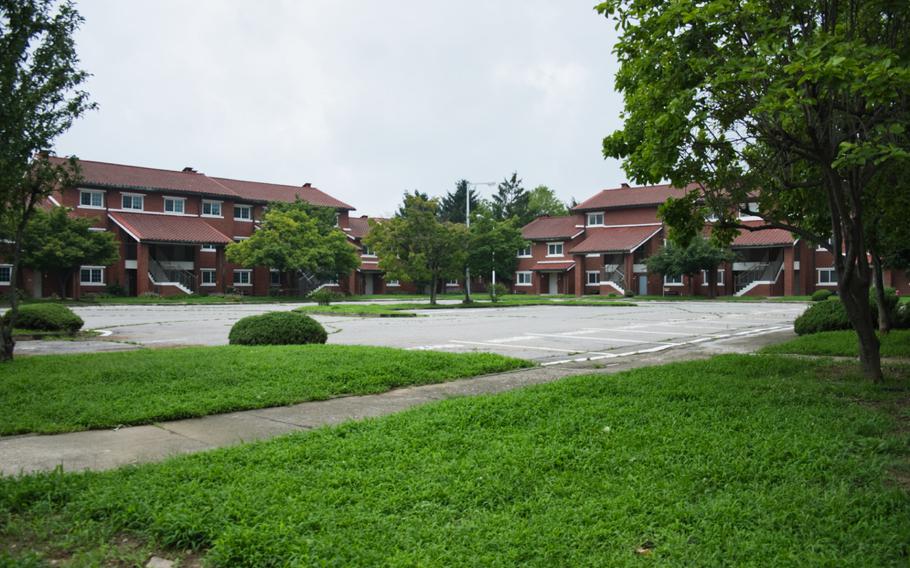
The South Korean government took ownership of Yongsan Garrison's Black Hawk Village, which consists of 18 buildings, two playgrounds and a barbecue pit, in January 2020. The brick townhouses once houses U.S. officers and their families. (Matthew Keeler/Stars and Stripes)
SEOUL, South Korea — It doesn’t look much like a park yet. The playgrounds are roped off and the main attractions are brick townhouses that not long ago were home to American officers and their families.
But South Korea has gained control of a sliver of land on the southeastern tip of the Army’s Yongsan Garrison, nearly two decades after the allies set in motion a plan to relocate the bulk of American troops south of Seoul and return the property to the government.
The 12-acre area, formerly known as Black Hawk Village, opened to the public on Aug. 1, a small step toward fulfilling the government’s promise to turn the entire base into Seoul’s version of Central Park.
For now, the rest of Yongsan remains walled off and in American hands, although large sections have been closed and boarded up since U.S. Forces Korea and other commands moved their headquarters south to Camp Humphreys in 2017. The South Korean government sealed off the exhibit area from the garrison with a fence lined with concertina wire.
Black Hawk Village is meant to be a starting point for discussion about the future of the park, the government said, as it seeks public buy-in amid frustration over years of delays and changed plans.
Visitors wearing masks as protection against the coronavirus wandered the grounds on opening day, snapping selfies with the two- and three-story row houses in the background.
“The site of the base was closed to the public for a long time, but it’s being opened to South Koreans little by little,” said Won Hyojin, 38, who lives nearby and was getting her first glimpse inside the garrison.
“I went to New York once. I loved the city’s Central Park,” she said. “We hope this site becomes a similar park where this megacity, nature and people can co-exist.”
Yongsan Garrison has long been occupied by foreign forces. The Japanese used it as a military base during their 1910-45 occupation of the peninsula and the U.S. Army moved in after World War II.
The base was originally surrounded by dirt roads and farming villages, but it has been engulfed by high-rises and trendy stores as Seoul grew into an economic powerhouse after the 1950-53 Korean War.
Tens of thousands of soldiers and civilians lived and worked there, enjoying all the trappings of home, including American schools, food courts, post exchanges, a movie theater, a bowling alley and a commissary.
The United States and South Korea agreed in 2003 to move most American troops from Yongsan to Camp Humphreys in the rural area of Pyeongtaek, about 45 miles south of the capital.
The government then announced plans to create a park; however, plans to return the keys of Yongsan Garrison to South Korea have been complicated by construction delays at Camp Humphreys and ongoing negotiations over environmental and logistical issues.
A joint venture between South Korean firm IROJE Architects & Planners and the Dutch company West 8 won an international competition in 2012 with their master design dubbed “Healing: The Future Park.”
The Ministry of Land, Infrastructure and Transportation said it will confirm its vision for the park by the end of next year, but construction isn’t expected to be finished until 2027.
An earlier plan to use part of the base for a national police headquarters already has been revised. The headquarters will be built in a different location, expanding the area for the envisioned park to about 740 acres, the ministry said last month.
A joint government-civilian panel also has decided to incorporate into the park the existing War Memorial museum, which sits on the edge of the base.
“The government will come up with various ways for the people to participate in transforming the Yongsan base into the country’s first national park that reflects our hope for peace and the future,” Land Minister Kim Hyun-mee said in a press release.
The government took ownership of Black Hawk Village, which consists of 18 buildings, two playgrounds and a barbecue pit, in January.
So far, it has remodeled five of the buildings to create an exhibition space, including reference and discussion rooms, a cafe and a museum with a tabletop diorama that depicts the garrison in detail with miniature buildings.
The welcome center, the museum and the cafe, which consisted of a seating area but no refreshments, were open but other facilities were closed due to the pandemic.
“This land has finally come back to the bosom of South Korean citizens,” Song Sun Hee, 60, said as she strolled with her husband. “I feel like Yongsan Park is quiet and neat. There’s also a feeling of calmness.”
“But to be honest I’m not happy that it’s taking so long to come back to us,” she added. “It’s still not quite clear who’s going to foot the bill for environmental contamination at Yongsan Garrison, so there are unhappy campers. Things seem to have been going at a snail’s pace.”
The museum’s entrance is down the street to the left of the Yongsan visitor’s gate entrance or across the street from the Seobinggo subway station. The exhibition space is open from 9 a.m. to 5 p.m., Tuesday through Saturday.
gamel.kim@stripes.com Twitter: @kimgamel